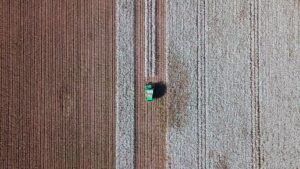Forest, Land and Agriculture: How Tapestry is targeting FLAG emissions


About Tapestry Inc.
Tapestry is a global house of iconic accessories and lifestyle brands including Coach and Kate Spade New York
- Coach is a global fashion house founded in New York in 1941, known for being crafted to last.
- Kate Spade New York, launched in 1993, is a global lifestyle brand known for being colorful, bold, and optimistic.
Summary
Some of the most significant challenges in transitioning to a nature positive and net zero fashion industry are related to Forest, Land, and Agriculture (FLAG) impacts, particularly within complex supply chains.
Tapestry’s journey to set the Science Based Targets initiative’s (SBTi) FLAG targets, which align with the Paris Agreement’s goal of limiting warming to 1.5°C, provides valuable insights for other fashion brands about the importance of leadership buy-in, data gathering and supply chain engagement.
Why focus on FLAG?
Today’s fashion industry could not function without the vast resources, materials and ecosystem services of the Forest, Land and Agriculture (FLAG) sector – opening up significant risks and opportunities for brands, manufacturers and producers, when it comes to the climate and nature crises.
According to the Science Based Targets initiative (SBTi), FLAG is the third highest emitting sector after energy and industry. Yet with emission reduction measures and removals, it is estimated that, by 2030, the sector could deliver more than a third (~37%) of the global climate mitigation necessary to stay within a 1.5C trajectory. (1)
To address this, the Science Based Targets initiative (SBTi) requires companies with significant land-use emissions (20% or more of their total Scope 1, 2, and 3 emissions) to set separate FLAG targets, alongside their other SBTi targets.

Tapestry’s FLAG journey
Tapestry signed onto SBTi’s Business Ambition for 1.5°C in September 2021. As their FLAG-related emissions exceeded the 20% threshold, they became one of the first fashion brands to begin the process of creating validated FLAG targets in addition to their energy/industry targets and these were validated by SBTi in May 2024.
Tapestry has set a FLAG target of reducing Scope 3 FLAG emissions 30% by FY2030 from a FY2021 baseline. This is part of a wider emissions reduction strategy that aims to reach net-zero GHG emissions across Tapestry’s value chain by 2050.
FLAG targets are significantly influenced by approaches to materials use. In Tapestry’s case, its use of leather is the primary driver of its FLAG emissions, and they are developing solutions to reduce these.
Tapestry’s goal is to source 10% of its leather from farms using regenerative practices, made with recycled inputs or from ‘next-generation’ materials by 2030. For example, Tapestry invested in Generation Phoenix, which uses wet blue leather offcuts, destined for landfill, to create a new and durable material that has at least an 80% lower carbon footprint compared to the global average of conventional leather.

FLAG: Targeting reduction and removal
FLAG targets are measured on a net basis, taking into account both the reduction and the removal of emissions.
SBTi urges companies to prioritise emission reductions as they represent 62% of the mitigation potential in the FLAG sector, while removals represent 38%. (2)
Companies setting FLAG targets are expected to develop GHG inventories aligned with the draft GHG Protocol Land Sector and Removals Guidance. There are multiple categories of FLAG emissions and removals that companies must account for when setting FLAG targets, including:
- Land use change (LUC) emissions from changes to how a given area of land is used and encompass the loss of carbon stock (carbon trapped in land) due to deforestation or the conversion or draining of coastal wetlands, peatlands, savannas and natural grasslands.
- Land management emissions from business activities associated with the use and management of land, such as fertilizers, biomass burning or forest harvest and management.
- Biogenic removals: which increase land-based carbon storage occurring within the boundaries of FLAG targets. Examples include forest restoration, silvopasture, agroforestry or soil carbon sequestration.

Challenges
Upstream impact accounting
Accounting for the impact of interventions further upstream in the supply chain, such as regenerative agriculture or improved cattle grazing practices, is challenging within current GHG Protocol accounting frameworks for downstream companies like Tapestry.
Evolving guidance
The SBTi FLAG guidance relies on the GHG Protocol Land Sector and Removals Guidance, which is still in draft form. This is an evolving landscape, which requires flexibility.
Data accuracy
While Tapestry has a robust traceability program, the industry is not at a point where detailed direct and indirect farm-level data is consistently available for cattle. This means that evaluating the impact of leather – which is a byproduct of the food industry – necessitates using more general data, such as country-of-origin averages, which limits accuracy.

Tapestry’s Approach
Even before the FLAG target setting process, the importance of corporate responsibility, including environmental sustainability, had been emphasised as a key pillar within Tapestry and an expectation of all suppliers. This was supported at the highest level, with clear messaging from leadership to reinforce that.
In 2022, Tapestry also shifted its Sustainability Team from under the Legal department to reporting directly to the Chief Supply Chain Officer. This integration allowed for closer collaboration with sourcing teams and better embedding of sustainability goals, such as FLAG targets, within business operations.
In order to better understand its impacts and put in place the most effective solutions, Tapestry has invested in a program to achieve high levels of traceability for its raw materials, setting a target for 95% mapping and traceability by the end of 2025. Despite farm-level data remaining a challenge, the program provides a foundation for understanding origins and engaging with suppliers.
Key learnings
Internal alignment is crucial
Success requires strong collaboration across departments, including finance and sustainability teams, and ensuring the business side understands and supports sustainability goals. By integrating the Sustainability Team within the supply chain structure they were able to work more closely on sourcing decisions and business operations, including those related to FLAG.
Supplier relationships must be strong
Building strong relationships based on trust and transparency with suppliers is essential for driving change in complex value chains. This involves open dialogue, understanding their challenges, and tailoring support.
Data challenges require collective solutions
Addressing the lack of granular, farm-level data for complex commodities like leather requires industry-wide effort and collaboration to develop better data collection methods and emission factors. Accounting standards also need to evolve to better accommodate upstream interventions for downstream companies.

Looking ahead
Tapestry is continuing to work on refining its approach to FLAG emissions and supply chain engagement. This includes exploring methods for improving the accuracy of data used for FLAG accounting and potentially identifying partners to help source better emission factors or farm-level data. They are also developing approaches to properly account for the benefits of upstream interventions within their Scope 3 inventory.
Future steps include exploring funding and supporting investments further upstream in the supply chain, like initiatives around feed additives for cattle to reduce methane emissions from the animals.

